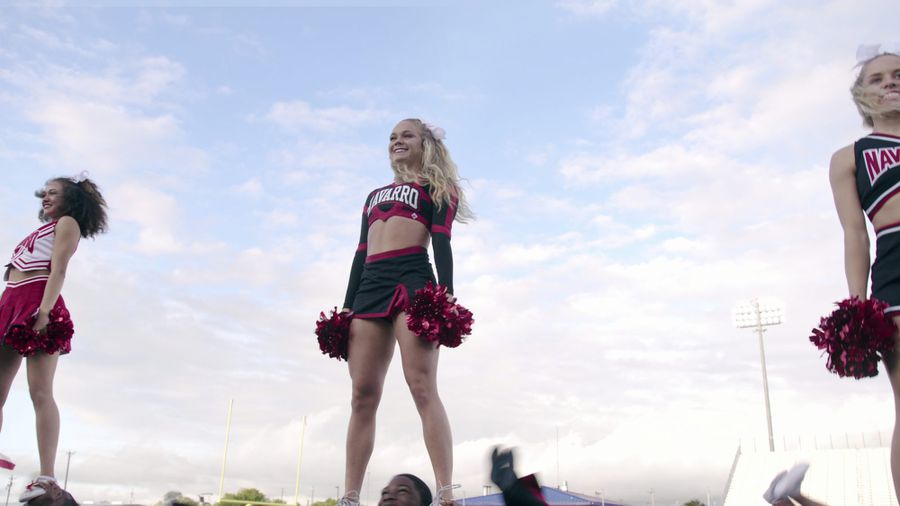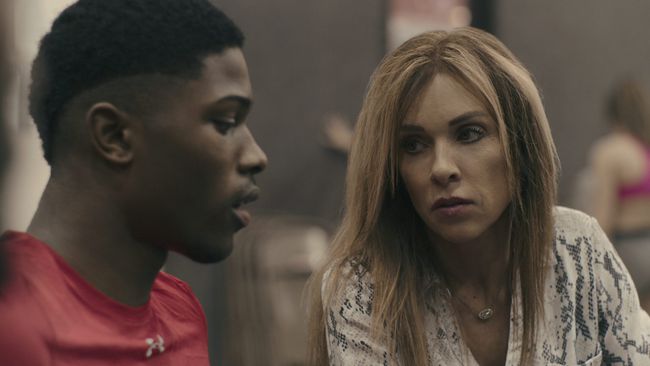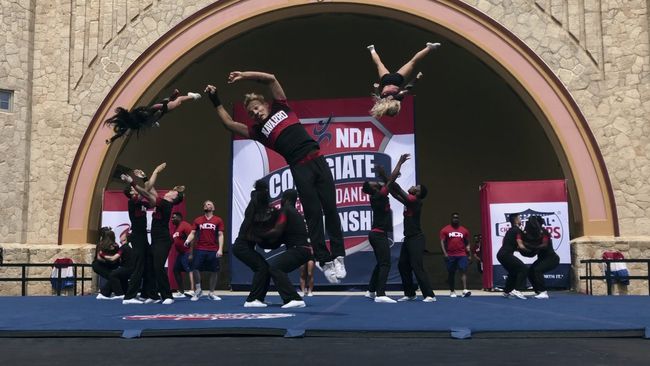
Bitchy. Popular. Ditzy. Slutty.
If you’ve watched the show, caught the squad on their appearance on Ellen, read about their boss-of-a-coach Monica Aldama, or seen Jerry “mat talk” people at work, then you already know what the (very real) hype around Cheer is all about. It shows real cheerleading, finally.
Unlike traditional cheerleading (circa the late 1960s, when cheerleading first became popular), most youth, high school, college, and all-star (aka rec or club) teams today don’t exist to cheer on football or basketball games. Rather, they spend their practice time prepping for competitions of their own, in which they perform rigorous routines (often two and a half minutes long) for judges that are scored on difficulty, execution, and overall impression. They practice all year to perform this routine just once or twice at a competition—and if anything goes awry, that’s just too bad. There’s no next play, quarter, or overtime presenting the opportunity for a comeback.
An audience's expectations of cheerleaders? A universally-owned hype squad that exists only to support others' hard work and triumphs, even when no one seems to be acknowledging their own.
Cheer shows the reality of prepping for these competitions: long hours, two-a-day practices, compounding injuries, and tireless dedication. Despite all this effort, though, the outdated cheerleading stereotype lingers, as does the expectation that cheerleaders will perform at other sporting events. Modern-day school teams juggle football and basketball games and other public appearances (think: parades and pep rallies) where the team is required to meet the audience's expectations of cheerleaders: a universally-owned hype squad that exists only to support others' hard work and triumphs, even when no one seems to be acknowledging their own. In fact, many cheerleading teams are expected to perform this side-hustle with little thanks or recognition from their community or the athletes they’re cheering on. Cheer makes a point to demonstrate that many of the community members and even the faculty of Navarro College are completely unaware that the school’s cheerleading team is one of the best in the country—like the New England Patriots of college cheerleading if you will. (Yes, people have compared coach Aldama to Bill Belichick.)

While other sports have a second string or a B-team (or are entirely individual), cheerleading is the epitome of a team sport. When one person is out of line or off their game, the whole team suffers; stunts will fall, people will drop, injuries will happen. While a team (like Navarro) may be lucky enough to have some alternate athletes, that's not always the case. Even if they do, Cheer shows how skills vary enough from cheerleader to cheerleader that it makes the 1:1 replacement of someone who’s injured or sick pretty much impossible. Subbing in someone who isn't perfect for the job doesn't just result in a less-than-stellar performance—it poses a risk for everyone involved. The result? You do what you need to do to make your skills—and the routine—happen.
The docuseries spotlights this exact dilemma during a dramatic turn of events as Navarro preps for the National Cheerleading Association (NCA) College Nationals in Daytona Beach, Florida (the most infamous college cheerleading competition of them all). But make no mistake: While the misfortune of some team members made for exceedingly good television, unfortunately, those kinds of experiences are the norm for most cheer teams. When 20+ people are depending on you and your entire year was spent building up to this one performance, it’s natural not only to feel like you need to push through the pain to do your job but also want to.

I’ve been a cheerleader since age 10 and have had my fair share of these same experiences. So, in case you thought the depiction of cheerleading presented in Cheer was exclusive to one of the best teams in the country, you’re mistaken. While I can't do skills of the same caliber as Navarro's athletes, I’ve injured myself during competition warm-ups and had to compete anyway. I’ve had to hop into a routine the day before competition because of rule changes, illnesses, and injuries. I’ve been responsible for giving team members concussions and broken noses (not proud of it), and given myself black eyes. I’ve torn muscles and bruised ribs. I’ve face-planted into the mat day after day in the name of performing a tumbling skill the team needed and expected of me. I’ve been asked to do something terrifying, looked at my coach, said "no problem," and did it anyway. I’ve cheered on the sideline of basketball games where I can hear both spectators and players complaining that we were even there. I’ve coached a team I was simultaneously part of because we didn’t have the budget to hire an actual coach. I’ve shown up to practice only to find out that the college tore apart the gymnastics gym we were using for practice space—just two weeks before heading to Daytona. (For the remainder of our practices, we had to drive an hour to a neighboring high school and borrow their mats just to continue prepping for the competition.)
These things don’t make me special. Talk to any cheerleader, and they can probably cite a running list that rivals (or out-does) mine. Both the individual sacrifices and larger issues (lack of respect and resources) are simply part of the sport.
You might be asking: Why would anyone put themselves through this? After all, this quote from Cheer’s Morgan Simianer sums up the “cheerleading kinda sucks” problem in a nutshell:
Morgan Simianer, Navarro Cheerleader from 'Cheer'
It’s crazy what we do, if you think about it, like…Whoever said let’s take two people and a back spot and chuck someone into the air and see how many times they can spin, how many times they can flip? That person is psychotic. But yeah, I’m the crazy person because I'm the one who does it.
Like many adrenaline-pumping sports, there’s a reason athletes are drawn to cheerleading. Walking straight up to the line of insanity, wondering “can my body even do that?” and doing it despite the fear is its own kind of empowering feat. Why else would people ride bikes down mountains, gymnasts attempt insane tricks, or ski jumpers do, well, any of the sh*t that they do? The thing is, doing it with the help of 20 other people simultaneously helps you make that leap and also makes it that much more weighty. This lets-all-jump-together mindset is what bonds cheerleading teams like nothing else. You don’t just go back for the adrenaline, the medals, or the chance to do a hair whip from 30 feet in the air; you go back because you’ve felt what it’s like to be part of something bigger than yourself, to be held up by others and to simultaneously hold others up. You get punched in the face, and you still catch the person who did it and is now flying down from mid-air. It’s a special kind of unconditional love. (Maybe cheerleading is the reason I can’t stay mad at people?!) Anything less than a “we’ve got this” attitude will permeate the team, and things will not go smoothly. When you nail a new skill, the group win feels unlike any other high. (Too many times to count, I’ve had chills—while sweating profusely—for this exact reason.) And when things go awry (as they will, when you’re throwing people in the air), well, there’s science showing that pain and suffering bring people together.
Cheer is the first time cheerleading has been properly presented to the masses in all its hairspray-covered black-and-blue glory. While the reaction to the series has largely been positive, some people are shocked and horrified by the drill sergeant-like nature of coach Aldama and the fact that these college athletes are pushed past the point of breaking. Yes, the sport is incredibly dangerous by nature—but let’s not forget the stage on which cheerleading was built: On the sidelines of a sport where tackling people while wearing protective gear from head to toe is the name of the game. So when cheerleaders started throwing people in the air, doing elite tricks, competing for themselves, and still weren't getting the acknowledgment they deserve? It's no wonder these athletes are gunning it towards absolute craziness. It's in response to the team pressure, their coach’s expectations, and their own desire to do what they need to for the team (and for first place)—but also, truly, for a little bit of respect.
